Recovery Formulas for “Lingering Evil Qi”
Originally published April 1, 2021
Restoring health (huīfù jiànkāng 恢復健康) after surviving a challenging illness requires not only the replacement of the vital Qi and substances expended, but also expelling lingering etiological factors. In Traditional Chinese Medicine (TCM), these lingering factors are known as Fú xié 伏邪, literally, “Concealed Evil Qi”. In this article, I explore strategies that are designed for the restoration of healthy functioning from Fú xié after a patient has tested seronegative for SARS Cov-2. These patients no longer suffer from COVID-19, but require various remedies to tonify the Qi, Yin, and Blood, and dispel the Lingering Evil Qi to provide for the free flow of Qi that promotes health and normal homeostasis. This condition is becoming widespread affecting both adults and children.

Mayway has collected six formulas and placed them in the Templates section of our Dispensary Service, under the category name “Recovery”. The sources of these formula templates are extracted from Guidance for Corona Virus Disease 2019, edited by the National Health Commission of the Peoples Republic of China, now in its 6th Edition (the English language version of this 135-page book can be downloaded here) or are published based on research from Hubei Provincial Hospital and Wuhan Union Hospital (see sources below). Others are suggested in a 9-unit CE/PDA course, “Lingering Pathogens” taught by William Maclean. This course is an excellent and complete discussion, most of which is not taught in TCM schools, which explores both Fú xié and Gu Syndrome. (This distance education course is offered from Mayway Herbs and can be accessed at the Mayway Education website.)
What is Lingering Evil Qi?
Fú xié was described in both the Shang Han Lun and Wen Bing. Essentially, it is a source of disharmony that remains in the body after recovery from an illness that induces chronic or intermittent clinical signs that are inconsistent with what would be considered normal health. The cause of this disharmony could be remaining etiological factor (bìng xié 病邪) that has not been completely dispelled or cleared from the body. The original factor that may once have been present has diminished so that only an echo remains. Almost always, nothing can be detected serologically but the clinical signs recur when a person is fatigued or stressed. Often, the individual simply does not feel well. Arguably, the Bìng xié may indeed be absent and the disharmony is a natural result of the body’s response to the insult via the functioning of the anti-pathogenic Qi, e.g., damaged tissue due to the inflammatory response of the immune system. Regardless, the result is the Upright Qi (zhèng qì 正氣) is compromised in these individuals.
When the initial symptoms of Lingering Evil Qi appear, they look like a warm disease, but lack the formal progression from superficial to deep. They appear with characteristics of internal Heat or Damp Heat, Yin damage, Qi deficiency, or possibly Blood stasis. The original etiological factor involved is either Heat or Damp Heat, which have been seemingly dispelled, cleared, or resolved, but remnants settle in the lower Qi, Ying, or Xue Levels, or alternatively, in the Shao Yang, Tai Yin, or Shao Yin Stages. Often, this disharmony is located within a particular level or location in the body and either primarily affects a particular Zang Fu, or sometimes multiple organ systems or tissues, including blood vessels, the brain, and the nervous system.
Heat in the body can be the nature of the etiological factor or the result of any Bìng xié turning into Heat when it encounters the Wèi (衞) and Zhèng Qì. A Yang expansive Bìng xié, Heat can easily change locations quickly. Heat damages the Yin, which may result in Yin deficient Heat, and, at the deeper levels, Heat congeals Blood.
Individuals with Damp constitutions, including those with excess adipose tissue and those who consume damp diets (e.g., high fat and excess alcohol use) are more susceptible to Damp Heat-causing disharmonies. Damp Heat is a mixed Yin and Yang Bing xie. The Heat “cooks” the Damp making it viscous and sticky, while the Dampness is said to wrap the Heat muting its expression and making it more difficult to clear.
Fatigue is a common component of a Lingering Evil Qi and it is usually not related to energy expenditure and may be worse with inactivity and/or sleep. This fatigue may be accompanied with a sense of weakness that is both mental and physical and may include tired and weak muscles, foggy-headedness, and poor concentration.
Strategies for Recovery from Fú Xié by Location/Stage
Wèi Level (wèi fēn 衞分)
Technically speaking, Bìng xié in this level are not lingering etiological factors but are active ones that require appropriate remedies that clear, dispel, drain, and/or resolve.
Qi Level (qì fēn 氣分)
The Qi Level is the second and main level of defense against invading Evil Qi (xié qì 邪氣). This is where the body, lying between the surface and the deeper Yin organ systems, mounts its most robust response, to prevent Evil Qi from gaining access to the deepest and most vulnerable Zang Fu. The Qi Level is associated functionally and structurally with the Lungs, Stomach/Intestines, Spleen, and skeletal muscles.
The Qi Level has different depths with the Lungs and Stomach located in the most superficial level where Heat is the primary Fú xié. The deeper level is comprised of the deeper portion of the Lungs and the Spleen, which are usually affected by Damp Heat.
One of the key features of a lingering Qi Level pattern is that a lot of Zheng Qi is consumed in combating the Evil Qi and a great deal of damage can be caused to both Qi and Yin, including fluids and blood. The loss of Qi and Yin compounds the inability of the anti-pathogenic (Zhèng) Qi to throw off the Fú xié completely. Supplementing these factors is the primary strategy for the recovery of health from Lingering Evil Qi in the Qi Level.
Hubei Recovery Phase
Tonify Qi, Nourish Yin, Tonify Lung and Open the Collaterals
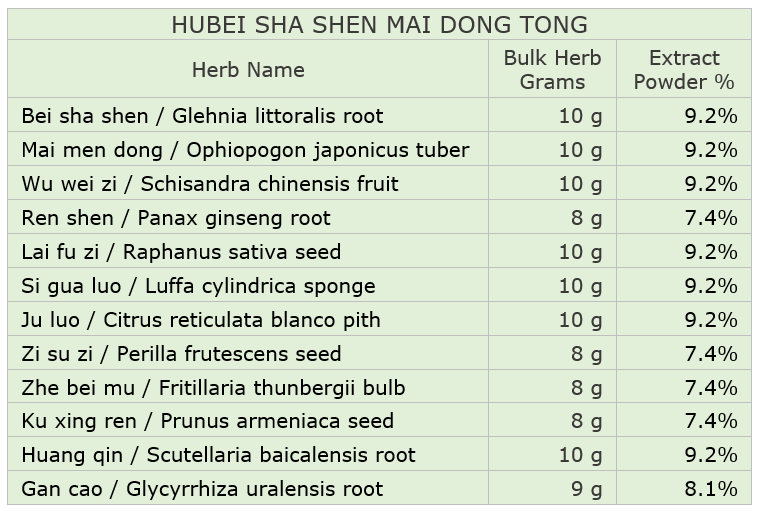
Although we have created a template suitable for tailoring in the Prescription Service, Mayway Herbs offers this formula in a pre-made extract powder, MW# 3119C. This article on our website features a discussion of this formula.
This slightly different formula with the same intent can be found as a template in the Prescription Service:
Wuhan Recovery Phase
Strengthen Lung and Spleen, tonify Qi, nourish Yin
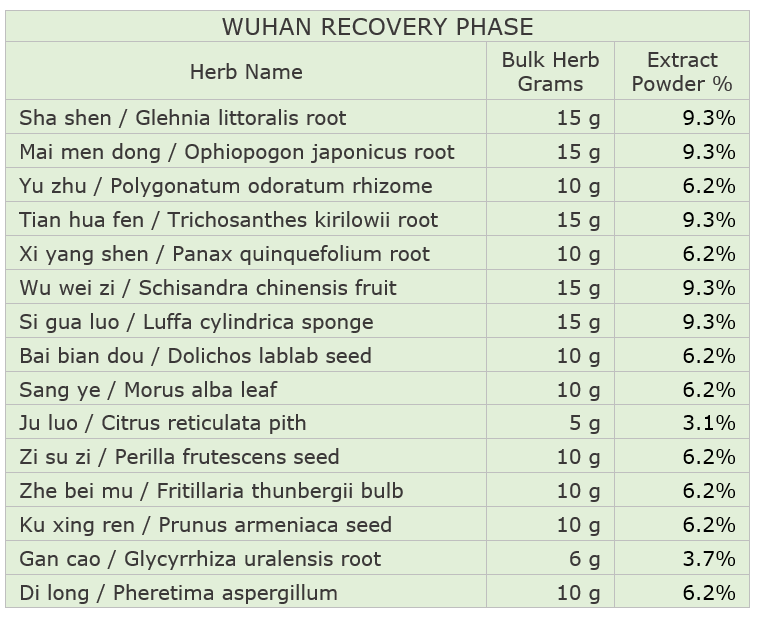
PRC National Health Commission Recovery Formulas
Two formula templates address this lingering Qi Level pattern. The first focuses primarily Lung and Spleen deficiency with signs of lingering Damp.
PRC LU & SP Deficiency Formula
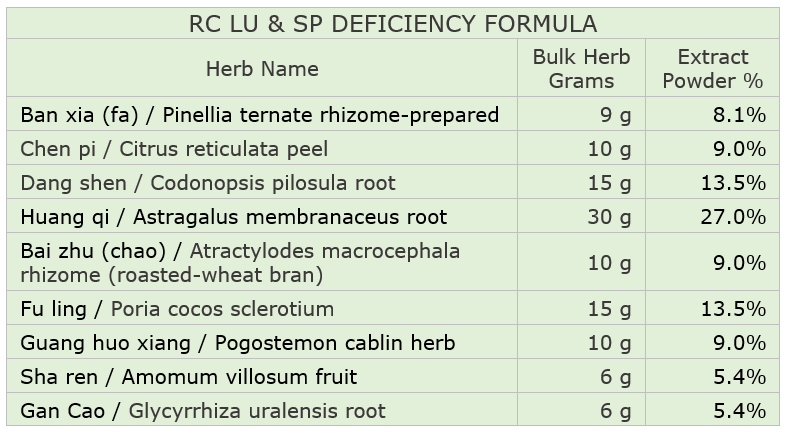
The second is aimed at Qi and Yin deficiency:
PRC Qi & Yin Deficiency Formula
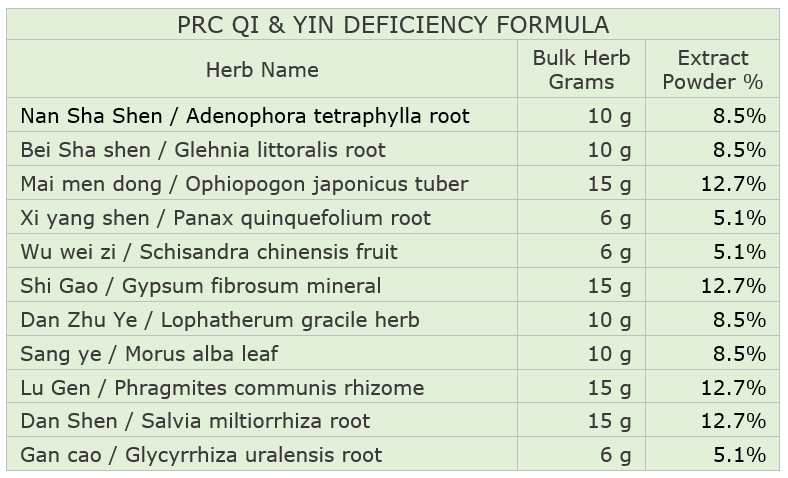
When the Lingering Evil Qi has become lodged in the lower reaches of the Qi Level, Lung signs may be absent and there may be clear digestive issues including Spleen Qi deficiency and possible loose stools indicating residual Dampness. In such a case the following formula template may prove useful:
Chinese Medicine Journal Middle Jiao Recovery Formula
Tonifies Spleen Qi and Resolves Dampness
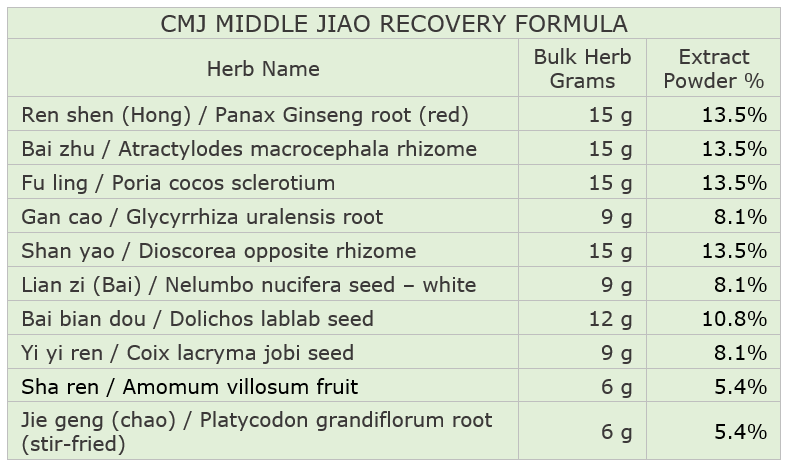
Shao Yang Syndrome
Lingering Evil Qi can lodge deeper in the body than what may be understood as the Qi Level. Given the classic signs, the patient may be assessed as demonstrating Shao Yang Syndrome (shǎo yáng bìng zhèng 少陽病症).External evils that attack the Qi Level that are insufficiently dispelled, sink into the Shao Yang.
The Shao Yang is not as clearly localized as the Qi Level, but a kind of subset of it, and is located closer to the internal organs. The deepest level is the membrane source (mó yuán 膜原), classically considered to be located between the pleura (the membrane covering the lung) and diaphragm. Sometimes, this location of the Lingering Evil Qi is described as “half-outside and half-inside”.
The clinical signs of Shao Yang Syndrome include possible alternating fevers and chills, and, importantly, symptoms that come and go at irregular intervals. In addition, there may be hypochondriac oppression, nausea, irritability, vision disturbances, and a wiry pulse. Patients with pre-existing Liver/Gall Bladder disharmonies, such as Liver Qi stagnation, can be susceptible to Lingering Evil Qi penetrating into the Shao Yang because the expenditure of Qi necessary in fighting off the Evil makes the underlying stagnation worse.
The related channels are San Jiao, Gallbladder, Pericardium, and Liver. The treatment strategy is neither dispelling or releasing nor clearing or purging, but rather harmonizing. Harmonizing means getting the pathogen out by closing the space available to it, making the environment hostile by improving physiological function, and boosting anti-pathogenic Qi. Xiao Chai Hu Tang is particularly indicated in a case of Lingering Evil Qi since it not only fights Evil, but also contains herbs that tonify the Upright Qi.
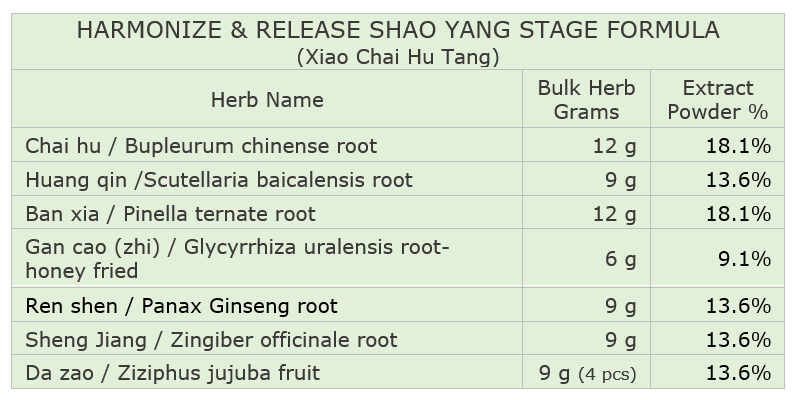
Lingering Evil Qi in the Nutritive and Blood Levels (yíng 營 & xuè fēn 血分)
Yíng and Xuè Fēn are the deepest levels of the body, corresponding with the Shao Yin (Heart and Kidneys) and Jue Yin (Liver and Pericardium), although the primary features of a Nutritive or Blood Level pattern are not organ specific but may be seen as more systemic.
Lingering pathogens in these levels have similar symptoms as acute illnesses but with much less intensity and severity including: a nocturnal fever usually without sweating, cognitive impairment, sleep disturbances, weight loss, possible internal Wind symptoms, blood stasis, and varying degrees of Yin damage or an exacerbation of Yang deficiency. A subset of Nutritive and Blood Level patterns is the Shao Yin which may show as Heart and/or Kidney injury. Depending on the patient’s constitution, diet and other factors, an Evil Qi that has managed to get into the Shao Yin can remain hot and damage Yin or lodge in place and further weaken Yang. Relying on a practitioner’s assessment, various formulas may be employed such as Jin Gui Shen Qi Wan for a Yang deficient pattern, or, depending on the amount of Yin damage, formulas ranging from Zhi Bai Di Huang Tang to Qing Hao Bie Jia Tang or Qing Ying Tang, in more severe cases. Clinical signs of Blood Stasis may require western medical intervention or the employment of herb formulas that invigorate the Blood and dispel Blood stasis such as Shen Tong Zhu Yu Tang or Tong Qiao Huo Xue Tang.
In Conclusion
Careful assessment of lingering factors (Fú xié) according to the level of the persistent symptoms can provide guidance to the practitioner in selecting various remedies that tonify the Qi, Yin, and Blood, and dislodge the Fú xié. The Chinese herbal formula templates described herein help create an opportunity for the restoration of the free flow of Qi and the repair of Yin damage that promotes health and normal homeostasis.
RESOURCES
- Bensky, D. & Barolet, R., Formulas and Strategies, Eastland Press: 1990.
- Bensky, D. et al., Chinese Herbal Medicine Materia Medica, 3rd ed., Eastland Press: 2004.
- Chen, J. & Chen T., Chinese Herbal Formulas and Applications, Art of Medicine Press: 2009.
- Chen, J. & Chen T., Chinese Medical Herbology and Pharmacology, Art of Medicine Press: 2004.
- Hubei Provincial Hospital of Traditional Chinese Medicine, “Agreement on Prevention and Treatment of Pneumonia Caused by Novel Coronavirus Infection by Traditional Chinese Medicine”, http://www.hubei.gov.cn/zhuanti/2020/gzxxgzbd/qfqk/202001/t20200125_2014934.shtml
- Luo, H., Gao, Y., Zou, J. et al., “Reflections on Treatment of COVID-19 with Traditional Chinese Medicine”, J. Chin Med 15, 94 (2020). https://doi.org/10.1186/s13020-020-00375-1, https://cmjournal.biomedcentral.com/articles/10.1186/s13020-020-00375-1.
- Maclean, Wm., “Lingering Pathogens: The Pathogenesis, Diagnosis and Treatment of Latent Pathogens”, Mayway Herbs Distance Education.
- National Health Commission of the PRC, “Guidelines for Prevention, Control, Diagnosis and Treatment of Novel Coronavirus Pneumonia, https://mp.weixin.qq.com/s/nOAmosQ4YqkXHKdJbBE9GA.
- Wei, G., Zhu, E., Wang, X., Wang, Z., “Feasibility of Yiqi Xuanbi Decoction Treating Pulmonary Fibrosis after New Coronary Pneumonia”. Journal of Shaanxi University of Chinese Medicine. 2020-03-19. 16:43:20: http://www.cqvip.com/QK/95794A/202005/7102861221.html.
- Wuhan Xiehe Hospital's "New Crown Traditional Chinese Medicine Prevention and Treatment Plan” (Second Edition), http://www.ycaqxh.org/portal/article/index/id/8577/cid/103.html.
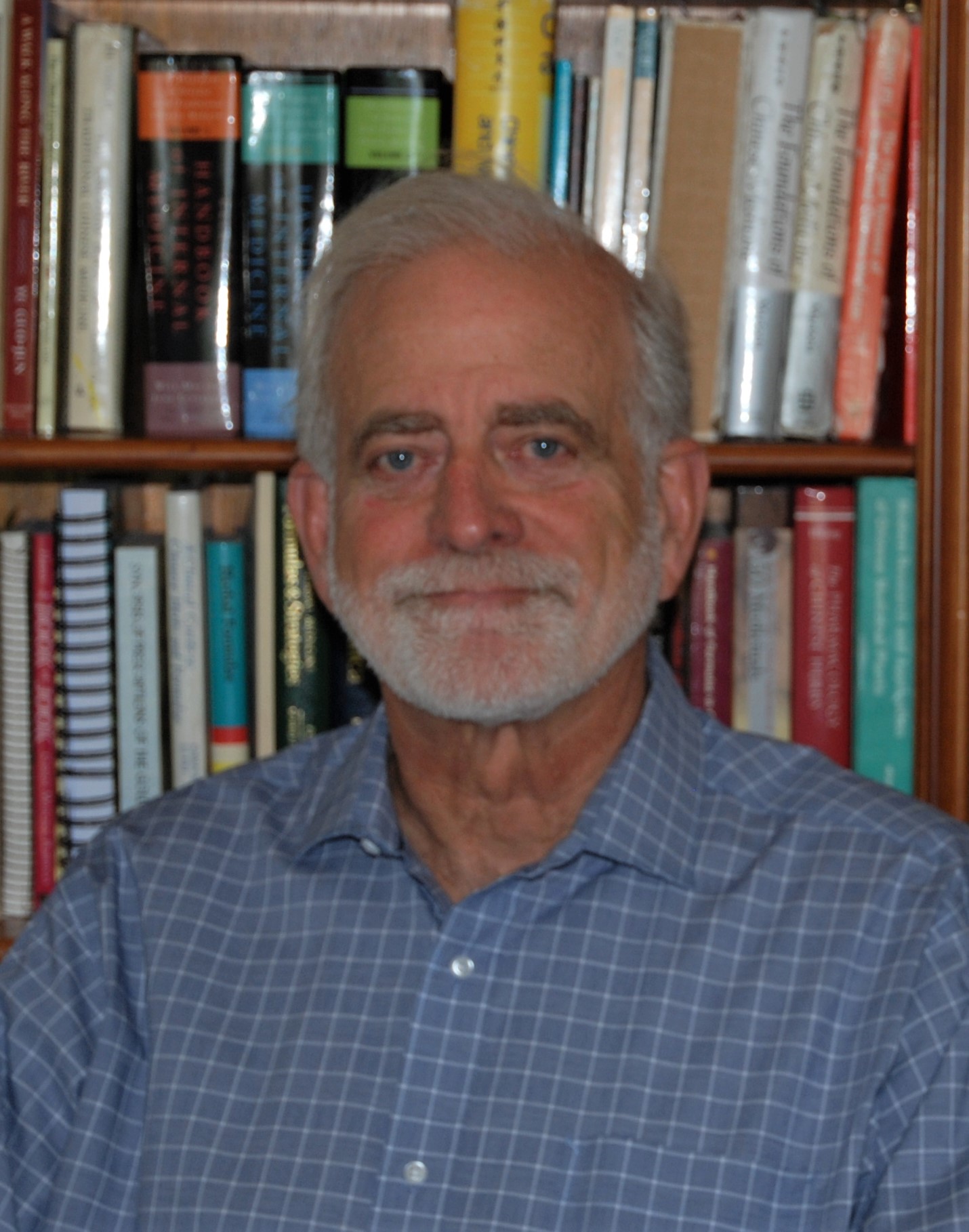 Bio: Skye Sturgeon, DAOM Bio: Skye Sturgeon, DAOMSkye is the Quality Assurance Manager and Special Consultant for Mayway, USA. Skye was the former Chair of Acupuncture & East Asian Medicine and core faculty member at Bastyr University, core faculty member and Faculty Council Chair at the American College of Traditional Chinese Medicine, and President and Senior Professor of the Acupuncture & Integrative Medicine College, Berkeley. Before making Chinese medicine his career choice, Skye held various positions in the Natural Foods Industry for 12 years and prior to that was a clinical biochemist and toxicologist. |

